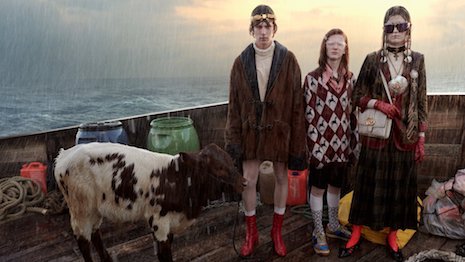- About
- Subscribe Now
- New York,
May 13, 2019

 Gucci parent company Kering has launched animal welfare guidelines. Image courtesy of Gucci
Gucci parent company Kering has launched animal welfare guidelines. Image courtesy of Gucci
French luxury conglomerate Kering is looking to help its own companies and its peers improve their animal welfare through the release of open-source standards.
Kering’s guide covers all of the species that are included throughout its supply chain, such as cattle, sheep and goats. In recent years, there has been a growing consumer focus on the treatment of animals within fashion production, and Kering’s standards are aiming to provide more transparency about its own practices.
Treatment transparency
To develop its standards, Kering consulted research and legislation and worked with experts including scientists, NGOs, farmers and herders over three years.
Kering has been working with farmers to implement the guidelines. The standards have three tiers, which range from a bronze level that meets or slightly exceeds existing European legislation to a gold level that represents the best in class.
The group notes that the current European Union regulations often are more stringent than the legislation that exists in other regions.
Some of the gold initiatives include raising animals in pastures and avoiding the use of sub-therapeutic antibiotics. Cattle and calves are also kept in a situation more closely mimicking being with their mothers for longer, with a diet that includes milk.
Kering is working to improve animal welfare in its supply chain. Image courtesy of Bottega Veneta
Kering says that the standards it has released would make more of an impact if they were to be implemented by more in the industry.
“Improving the welfare of animals must be an imperative for our industry and Kering wants to amplify the focus of attention from a few species to all of the animals, including livestock, within fashion’s global supply chains,” said Marie-Claire Daveu, chief sustainability officer and head of International institutional affairs at Kering, in a statement. “Reflecting François-Henri Pinault’s vision, our standards are aligned with our commitment to a holistic approach to sustainability, which means having best practices that encompass animals in our supply chains, wildlife around them and biodiversity conservation more broadly.
“We hope for widespread adoption of the standards through collaborating with our suppliers, our peers in luxury, the fashion industry at large and with the food sector, in these shared supply chains to ultimately shift how we, as a society, treat animals and nature,” she said.
Kering's sustainability efforts have been focused on not only impacting its own supply chain, but those of other companies in the industry.
In 2015, the group looked to drive awareness and progress within its own organization—and more widely—with the creation of a new methodology that uses financial terminology to measure environmental impact.
The formulas and methodology the group used for its Environmental Profits & Loss Account (E P&L) are open-sourced, enabling any competitor or company in another industry to value their own “natural capital” gains and losses. Kering recognizes that as only one company among many using the same suppliers, various companies will have to work together to enact change (see story).
Share your thoughts. Click here